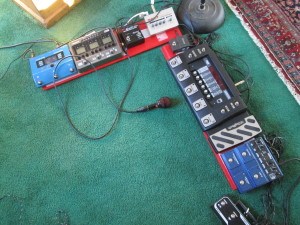
A Multi-Colored Piece for Harmonica as Organ
I recorded this improvised piece in my home studio last month. I wanted to try something where the structure of the piece is defined as much by changes in tone as by changes in harmony, and it worked nicely in this case.
I’m using my full rig in this recording, which means that I have two independent FX chains that can be run separately or combined (note: the photo shows my rig before I replaced the Zoom G3 with a Vox Stomplab IG):

Both chains go to a Nady 4-in 1-out (mono) mixer, which in turn feeds my Digitech JamMan Stereo looper (which wasn’t used in recording this piece). The looper, the mixer, and the ABY pedal are always in the chain.
I set the RP500 up to run one of my patches with a rotary speaker effect, the iStomp to add a low octave and a perfect 5th up to the RP500’s tone, and the Stomplab with a patch that includes a pitch shift of an octave down plus a big, distorted amp. When I run the RP500 without the rotary speaker and the iStomp, or the Stomplab by itself, the tone is that of a traditional amped blues harp; when the FX kick in the emotional context changes in a big way.
You can hear the various FX moving in and out of the piece as it proceeds, changing the colors and implying entrances and exits for different instruments. Sometimes the harp sounds like a big pipe organ, sometimes like a Hammond in a rock band, sometimes liked a fully amped-up blues harp. The range of tones and attacks notwithstanding, the overall emotion of the piece is beautiful and serene, whether I’m holding a simple chord with an organ sound, or playing a bluesy line with a corresponding tone.
I think this piece demonstrates well how a few effects can transform a simple structure, adding sonic and emotional depth to what might otherwise be too simple a piece to maintain interest for long. Besides the FX, I’ve used changes in chord voicings, from very close to spread out to a 10th, to signal big structural events. When you hear the drone in the low end of the harp against the 10th and 11th above, that’s played on the harp, not generated via FX.
As usual, I recorded the piece with a Zoom H4 positioned a few inches from the front grill of the Peavey KB2 keyboard amp that I use for most of my gigs. (That H4 is the best $300 I ever spent on recording gear.) I normalized the volume of the recording; then I edited out about 17 seconds worth of stuff near the end of the piece, EQed and limited it. No other manipulation was done on the recording. The music is presented in the order it was played, without overdubs.
Enjoy.
“Slow This Day” by Richard Hunter copyright 2015 R. Hunter/Turtle Hill Productions, all rights reserved
Audio Player
Tags In
Related Posts
1 Comment
Leave a Reply
You must be logged in to post a comment.
WHAT’S NEW
Categories
- Audio/Video
- Blog
- Blue Future
- Digitech RP Tricks and Tips
- Discography, CDs, Projects, Info, Notes
- Featured Video
- For the Beginner
- Gallery
- Hunter's Effects
- Hunter's Music
- Huntersounds for Fender Mustang
- Meet the Pros
- More Video
- MPH: Maw/Preston/Hunter
- My Three Big Contributions
- Player's Resources
- Pro Tips & Techniques
- Recommended Artists & Recordings
- Recommended Gear
- Recorded Performances
- Reviews, Interviews, Testimonials
- The Lucky One
- Uncategorized
- Upcoming Performances
- Zoom G3 Tips and Tricks
Awesome! Love it!